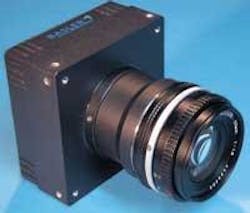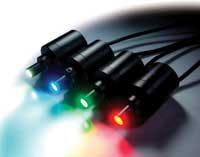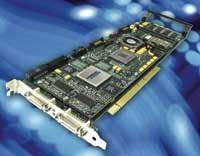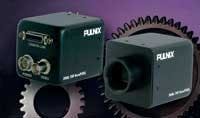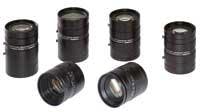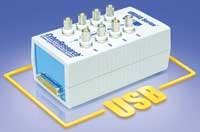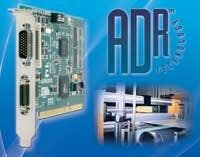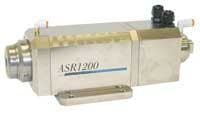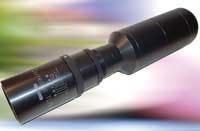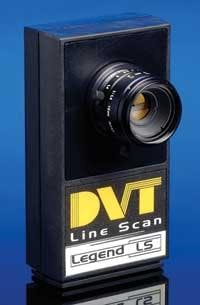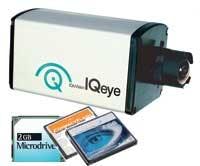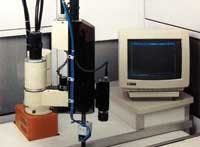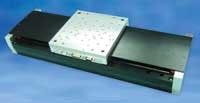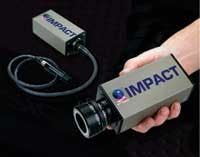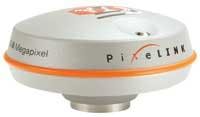Products
Area-scan cameras see color
Expanded A400 series cameras are now all in a color version. The CMOS sensor-based cameras produce up to 96 frames/s at full 2352 × 1726-pixel resolution; higher frame rates are possible when the area-of-interest (AOI) feature is used. These cameras offer better differentiation of image nuances than can be achieved with a monochrome camera. A programmable AOI and exposure time sequencer let the user program an automated sequence of changes in the camera’s AOI and exposure time settings without using the serial communications port. Using the sequencer results in shorter inspection cycle times.
Basler Vision Technologies
Ahrensburg, Germany
www.baslerweb.com
High-illumination lighting is stable
MG Wave high-power coaxial spot LED lights provide stable, high illumination for machine-vision applications requiring optimal lighting conditions. Designed to be compatible with machine microlenses, the small, lightweight MCEP Series lamps utilize proprietary collector optics and lightguides for maximum illumination. Stable illumination is ensured through use of a choice of dedicated single-channel or three-channel constant-current power sources. Two fiberoptic guide-connection options can be used with the high-power spot LEDs: the single-lamp type guide (MCEP-ADLG) and a three-lamp guide (MCEP-AD3LGB).
Moritex Europe
Cambridge, UK
www.moritex.com
Board processes in real time
Anaconda, a programmable board, is designed for real-time image acquisition, processing, and analysis. PCI-X compliant, the Anaconda is suited for embedded vision applications in fields such as diagnostic x-ray, flat-panel display, and semiconductor-wafer inspection. Features include autonomous program execution; FPGA accelerated real-time image processing; and powerPC-based embedded pattern search engine. The Anaconda is supported by Sapera LT software for acquisition and control, FPGA development specifications, image-processing libraries for the PowerPC, and several third-party development tools, enabling application development on Windows 2000 and XP.
Coreco Imaging
St.-Laurent, QC, Canada
www.imaging.com
High-speed camera catches action
TM-6740CL offers up to 200 frames/s at full resolution and generates up to 3205 frames/s in partial-scan and binning modes. This 1/3-in. VGA-format progressive-scan camera is based on the Kodak KAI-0340 CCD imager. Its 640 × 480-pixel resolution imager has 7.4-µm2 pixels. It also features both analog and digital Camera Link dual-tap output that is 8- or 10-bit software selectable. In addition, there is full asynchronous reset with electronic shutter up to 1/64,000 s or pulsewidth exposure control, which allows triggered image capture and processing. Readout-inhibit control makes multiple-camera applications possible. Housing is 50.8 × 50.8 × 85.1 mm.
JAI Pulnix
Sunnyvale, CA, USA
www.jaipulnix.com
Motion controller offers vision
Guidance 3400 is a compact motion controller with optional machine-vision capabilities and is based on a distributed network architecture that allows the controller to be located at point of use. The device controls four axes of motion and contains four motor drivers, six encoder input channels, a 700-MIPS processor, digital and analog inputs and outputs, and Ethernet, DeviceNet, and RS-232 interfaces. Guidance 3400 can produce up to 3000 W of motor power in a 180 × 70 × 70-mm package. Interface is based on a Web server in the controller.
Precise Automation
Los Altos, CA, USA
www.preciseautomation.com
High-resolution lenses have fixed focal length
Two series of 1- and 2/3-in.-format, fixed-focal-length lenses are designed for large-format (5-Mpixel), high-speed cameras; linescan cameras; and super high-resolution camera applications. All lenses in both series have an enhanced image-recognition rate, accomplished through a reduction in image distortion and an increase in the marginal light quantity rate; a new focusing device with enhanced performance for close shooting; and a highly stable body, protecting the lens from vibrations and shocks applied during production or inspection.
Fujinon
Wayne, NJ, USA
www.fujinoncctv.com
DVR software acquires video
StreamPix release 3.12 is a digital video-recording software package for acquiring live uncompressed or compressed video direct to hard disk or RAM. The software supports acquisition in both 8- and 10-bit format and direct-to-disk in color at 640 × 480 × 210 frames/s × RGB using real time conversion with Matrox Helios. StreamPix can acquire at 210 frames/s using the ImperX IPX-VGA 210 or the Silicon Imaging Si640HF cameras.
NorPix
Montreal, QC, Canada
www.norpix.com
DAQ modules allow quick change
URDAQ data-acquisition modules add quick-change BNC connectors for short-term use in automated testing, process control, and lab setups. URDAQ 0814B and 0814DAB provide eight 14-bit, 250-kHz A/D channels and 24 TTL-level digital I/O channels. The 0814DAB includes four 14-bit D/A channels with a settling time of 1 ms to 0.1% of full scale. Analog output channels are available on a DB-9F connector, and digital I/O channels appear on a DB-25M connector. The modules come with calibration software, support USB 1.1 and 2.0, and can be powered by USB cable or external power source.
CyberResearch
Branford, CT, USA
www.cyberresearch.com
Linescan board is fast
Digital Camera Link frame grabber, Grablink Avenue, supports one area- or linescan camera in the Base configuration. The board includes ADR, a proprietary method for digital acquisition from linescan cameras at variable web speed. A 64-bit, 66-MHz PCI bus (3-V/5-V signaling) allows it to sustain a data transfer of 85 MHz. Grablink Avenue is equipped with on-board memory, line trigger, and various I/O lines. For area-scan applications, the frame grabber offers asynchronous reset exposure control.
Euresys
Angleur, Belgium
www.euresys.com
Control software is upgraded
PictureFrame 2.2, a camera-control package and image-processing suite, includes a graphical user interface that controls a tunable liquid-crystal RGB filter. Three independent exposures can be taken and combined automatically, generating a high-resolution RGB color image. Other features include autoexposure, real-time six-channel user-adjustable color correction with customizable algorithm for precise color reproduction, live pseudocoloring that permits the human eye to discriminate in real time millions of intensity levels within a monochrome image, and live frame averaging with motion-compensation control that increases dynamic range and reduces read noise. PictureFrame 2.2 is a free upgrade to all earlier versions of PictureFrame and is available for download from the company’s Web site.
Optronics
Santa Barbara, CA, USA
www.optronics.com
Rotary stage is sealed
ASR1200 series direct-drive rotary stage has an integral pneumatically operated collet chuck for automated material handling and a sealed water jacket for wet cutting processes. Features include clear aperture for product feedthrough; threaded collet retainer that enables rapid tooling changeover; low inertia shaft for maximum acceleration; direct-drive brushless motor and encoder; and maintenance-free frictionless rotary union.
Aerotech
Pittsburgh, PA, USA
www.aerotech.com
Telecentric lenses fit megapixel cameras
Telecentric lens series is for megapixel cameras up to 15 × 15 mm. Available magnifications are 0.3X (S5LPJ6060), 0.5X (S5LPJ2499), as well as 3X (S5LPJ0412) and 5X (S5LPJ9325). The lenses provide a standard thread M42 × 1 or Nikon-Bajonett adapters. Further magnifications are in production. An ultracompact lens (S5LPJ7041) is for applications with limited space; it has a magnification of 0.2X with a 1/2-in. CCD at a total track of 100 mm.
Sill Optics
Wendelstein, Germany
www.silloptics.de
Cameras have digital pan/zoom
Cameras with a digital pan and zoom processor have computer-controlled, pixel-accurate ROI panning and multitap filter-based digital zoom for flexible application. All camera controls are done via a 1394 (FireWire) interface, which includes a fully programmable image-processing pipeline and dynamic-range/gamma-control LUT for any desired response curve. An on-board image buffer is featured, as well as a range of triggering and strobe-control capabilities. The cameras come with driver software and a user’s manual.
The Imaging Solutions Group
Rochester, NY, USA
www.isgchips.com
Toolkit sets up IR cameras
Toolkit provides a comprehensive set of image-acquisition and analysis subroutines, as well as dynamic link libraries for the National Instruments LabVIEW programming environment. Provided on a CD, the toolkit enables users to acquire, store, retrieve, display, and process still images and video using the company’s IR cameras. Under LabVIEW, users control IR cameras and setup parameters such as integration time, and triggering conditions.
CEDIP Infrared Systems
Croissy-Beaubourg, France
www.cedip-infrared.com
Linescan camera has high speed
Using a Texas Instruments DSP, the Legend LS acquires an image of a moving object at up to 18,000 lines/s. The camera can accommodate acquisitions of up to 8190 × 2048 pixels. This feature makes the LS line scanner suitable for high-resolution applications that need a larger viewing area, especially in the direction of part motion. Intellect software provides consistent spatial sampling information. This continuous coordination allows speed changes that affect the application’s process to be mirrored in the image-acquisition process, ensuring a continuous image.
DVT
Duluth, GA, USA
www.dvtsensors.com
Image system records to card
IQevent, a self-contained camera and recording system, records up to 40,000 ultrahigh-resolution images without using bandwidth. PC/client software is not required, as the viewing and management of the video is all done in a Web browser. The PCcard standard format allows the recording cards to be removed and replaced easily and provides a simple upgrade path. Support for the open-file-standard FAT32 and the open-imaging-standard JPEG allows the images stored on the cards to be read without special software in almost any laptop or PC with a card slot.
IQinVision
San Clemente, CA, USA
www.iqeye.com
Automated tool analyzes inkjets
Analytical measurement tool, the Drop Watcher III, provides automated, repeatable, and exact measurements of inkjet-drop formation and flight characteristics from a range of print heads for any jetable fluid. It incorporates a precision x-y motion-control subsystem that automatically moves the camera and microscope across all the nozzles in the print head to enable complete characterization of the print-head jetting properties. The microscope, camera, and LED strobe are accurately positioned and focused at each nozzle and automatically measure drop formation time, size, velocity, tail merge, and flight time to the substrate. The 50-mm, monochrome CCD camera and digital image capture allow quick, accurate, and consistent measurement analysis of both opaque and transparent fluids.
imaging Technology international
Boulder, CO, USA
www.imagingtechnologycorp.com
Software facilitates process control
Industrial-automation software suite, FactoryFloor 4.1, is designed for use with Opto 22 process-automation controllers, typically combined with the company’s SNAP Ethernet I/O and SNAP Serial I/O products. With FactoryFloor 4.1 users can develop control programs, design human-machine interfaces, expand their control systems’ connectivity to enterprise databases, and complete control and data-acquisition projects. The suite is comprised of four components: OptoControl, OptoDisplay, OptoServer, and OptoConnect. Also included are assorted OptoUtilities including OptoTerm, which assists users in downloading and executing control strategies, and OptoSniff for troubleshooting communications.
Opto 22
Temecula CA, USA
www.opto22.com
Graphic interface connects IR sensors
Multi-Sensor Interface (MSI) for Modline 5 series of IR sensors enables users to access configuration and temperature data for up to 12 sensors over plantwide networks and the Internet via an embedded Web-browser interface. A NEMA 4X-rated, 10.4-in. touch panel color display, the MSI comes preloaded with graphic screens presenting Modline 5 sensor configuration, status, current temperature, historical trends, and temperature alarms. Without any user programming, the unit provides an overview of Modline 5 sensors interconnected by an RS-485 network.
Ircon
Niles, IL, USA
www.ircon.com
Modules calibrate cameras
RoboCAL software module is a generic camera-calibration component for machine-vision applications where the camera may be static, mounted on the robot arm at any orientation, or mounted on the quill or theta axis of a robot/positioning system. System developers can maximize performance and cost-effectiveness by using any combination of robots and vision systems without having to calibrate the cameras, especially with arm or quill-mounted cameras. The AccuTCP software module can be used in conjunction with RoboCAL to measure the tool center point of a robot or positioning system. Both modules can be used with any application that uses COM/DLL interface.
OptoMatix
Meridianville, AL, USA
www.optomatix.com
Linear stages are precise
IMS-LM series linear stages are designed for self-supporting applications with travel ranges from 300 to 600 mm. They are solutions for precision industrial applications such as semiconductor wafer inspection, microelectronics test and assembly, pick and place, DNA sequencing, or laser machining. The IMS-LM series utilizes a FEM optimized aluminum extruded body that is extremely stiff, while minimizing the bending effect caused by different thermal-expansion coefficients of the aluminum body and the steel rails. Unlike screw-driven stages, the IMS-LM has a center-driven linear motor as the driving element that is noise-free and has high speed, acceleration, and system responsiveness with no wear of motor brushes or drive screws. The stages are more than 100 mm shorter than comparable screw-driven stages.
Newport
Irvine, CA, USA
www.newport.com
FPGA is customizable
Matrox Odyssey Xpro+, an enhanced version of the Matrox Odyssey Xpro scalable vision-processor board, integrates off-the-shelf and custom technologies with an established, fourth-generation architecture. It features the latest version of the freescale G4 PowerPC embedded microprocessor with a core frequency starting at 1.4 GHz, an Oasis processing and router ASIC, and a configurable coprocessor FPGA. This additional coprocessor is based on the Altera Stratix II family of pin-compatible FPGA devices and includes a bank of QDRII SRAM, which delivers an aggregate memory bandwidth of 4 Gbytes/s. Binary operators, large LUT mappings, and warping operations are accelerated by the coprocessor FPGA, which can be further customized.
Matrox Imaging
Dorval, QC, Canada
www.matrox.com/imaging
Cameras automate inspection
IMPACT T25 is designed to give manufacturers greater accuracy and improved defect detection, and IMPACT T21 is a remote microhead-based camera, designed for tightly constrained mechanical requirements. Both offer the functionality of a full-featured, self-contained vision system. IMPACT T25 has 1024 × 768-pixel resolution, including a self-contained image processor and I/O. Supported by a high-speed CCD imaging sensor, it can capture and process images at rates of up to 5000 parts/min. IMPACT T21 is for inspecting electronic microcomponents and other small manufactured parts. Its microhead fits into small machines or tight spaces. Both of these cameras are fully supported by the company’s Inspection Builder software.
PPT Vision
Eden Prairie, MN, USA
www.pptvision.com
Microcamera images in visible/IR
Dual-wavelength visible-InGaAs MicroCamera is less than 70 grams and measures less than 26 cm³. The compact MicroCamera simultaneously images in both visible and near-IR wavelengths, producing a single, combined image. The camera has no moving parts, requires no field nonuniformity corrections, and operates at room temperature to yield a combined visible and SWIR image that previously required two cameras or much larger dual-wavelength detectors. The camera’s 320 × 256-pixel resolution array features a small pitch-25 µm versus the previous 40 µm.
Sensors Unlimited
Princeton, NJ, USA
www.sensorsinc.com
Cameras use compression
JPEG compression IP core, the CTJPEG-04 for FPGA-based intelligent cameras, can sustain 500 frames/s at a resolution of 1280 × 1024 pixels. The compression engine was customized from the CCI IP core library to fit FastVision FastCamera13 and FastCamera40. Based on the JPEG ISO/IEC IS 110918-1 standard image-compression algorithm, the design supports a continuous data flow and can be used in stringent video-compression applications without the support of a host or a coprocessor. This enables images captured to be compressed through a configurable user interface and to be transmitted to a host via a USB 2.0 standard interface. The core is fully synchronous and autonomous and offers localized image degradation when the high-frequency content in the processed images is too high.
Cadre Codesign
Montreal, QC, Canada
www.cadrecodesign.com
Gigabit Ethernet camera is smart
TAGPlus provides security and surveillance integrators with an audio/video platform by incorporating the company’s Smart Reader M1A technology and offering Gigabit Ethernet bandwidth. In addition there is an extended range of 13 Sony CCD sensors: from VGA to 1400 × 1000 and 1600 × 1200 and the camera comes in either B&W or color versions. An optional DSP coprocessor and an integrated auto-iris management function and audio input and output are available.
Tattile
Brescia, Italy
www.tattile.com
Software adds functions
Based on the company’s machine-vision library HALCON, ActivVisionTools version 3.0 support more than 40 image acquisition devices. Its new ActivOCR technology is a neural network classifier that enables rapid development of OCR applications and provides access to multiple camaras and frame grabbers. New interfaces are free for download on the company’s Web site.
MVTec Software
Munich, Germany
www.activ-vision-tools.com
Smart sensor speeds vision
Compact, 2-D smart sensor, the ZVF, offers speeds of 4, 6, or 12 ms. Intelligent lighting optimizes image quality. Images are transmitted digitally from sensor head to an amplifier and between amplifiers for clearer images. The ZFV sensor head provides a sensing view of 5 to 50 mm. Single-function or standard multifunction amplifiers are available.
Omron Electronics
Schaumburg, IL, USA
www.omron.com
Xenon strobe inspects webs
Checkline LS Series linear stroboscopes are for visual inspection of web products such as labels, printed material, textile fabrics, metals, and nonwoven material. A xenon light source and highly polished reflector generate high light intensity and uniformity. A steel enclosure is designed to dissipate heat and eliminates the need for heat sinks. Flash frequency can be automatically synchronized to web speed using an external sensor or manually using a adjustment knob. Flash intensity can be set manually using an adjustment knob or externally via a 0-6-Vdc output. LS Series strobes come in 10- (LS10) and 15-in. (LS15) models to accommodate webs up to 36 in. wide. Two or more units can be combined for continuous inspection of wider webs.
Electromatic Equipment
Cedarhurst, NY, USA
www.checkline.com
Camera has increased resolution
PL-A686 digital microscopy camera is a 1-in. CMOS sensor with 3.5-µm square pixels, providing resolution of 2208 × 3000 pixels in both color and monochrome versions. The 6.6-Mpixel resolution of the PL-A686 is complemented by controls to select a variable region of interest and five levels of decimation. The camera delivers 5 frames/s at full resolution with frame rates increasing for smaller regions of interest.
PixeLINK
Ottawa, ON, Canada
www.pixelink.com
Camera speeds imaging
DRC655 camera has been developed for use in applications requiring long recording times, up to 15 minutes or more, of high-speed digital data. Image data are streamed directly to a video-disk array. The camera head is a ruggedized EMI-resistant sealed enclosure containing the sensor and corresponding electronics, allowing the camera to image and transmit a high-speed digital stream via fiberoptics. There is an option to insert IRIG time range data directly into the camera and transmit the information with each frame to the controller over the fiberoptic interface and the recorder. Resolution is 1280 × 1024 pixels, and maximum frame rate is 500 frames/s at full resolution.
Photosonics
Burbank, CA, USA
www.photosonics.com
IR sees microscopically
Micro thermal imaging system, developed for microscopic applications, consists of the Infrasight thermal imaging camera, 20-µm lens, optical mounting table, vertical focusing stage, locking x-y stage with micrometers, adjustable cooling fan, Dell PC and display, cables, and Thermalyze image-analysis software. Thermal stage and controller, I/O module with eight relay outputs, and wide-angle lens are optional. The software provides 30-frames/s viewing, automatic emissivity correction, and tools to obtain temperature information. The camera obtains the temperature at 19,200 points on each image with temperature sensitivity of 0.2°C for the microscopic lens and 0.1°C with wide-angle lens.
OptoTherm
Sewickley, PA, USA
www.optotherm.com
Illuminators do not fluctuate
Model 21DC, DCS, DCP, and DCL are fluctuation-free dc-regulated light sources for machine-vision applications. The illuminators incorporate RS-232 PC control and optical feedback-loop stabilization. Depending on the model, lamp intensity can be controlled manually via the front panel, remotely through a DB-9 connector using 0-5-V analog, and/or digitally via an RS-232 interface.
StockerYale
Salem, NH, USA
www.stockeryale.com
